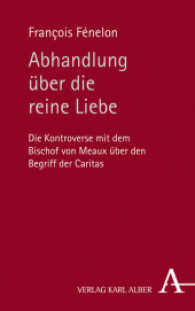- ホーム
- > 洋書
- > 英文書
- > Architecture
Full Description
Decolonising the Built Environment: Process, Product, and Pedagogy provides an important and much-needed comprehensive overview of how decolonisation is shaping the built environment in theory, in practice, and as a process/project today. The contributors provide an inclusive and trans-national conversation between a diverse set of academics, design practitioners and thinkers, and activists. This book is structured around three thematic and practical categories: Part 1 studies decolonisation conceptually; Part 2 studies decolonisation as a process; and Part 3 studies the products of decolonisation as materialised in the form of buildings, urban design, planning, policy, and social practices.
Essential reading for students, teachers, and practitioners, this book presents the project of decolonisation as a pedagogy and an ongoing process.
Contents
1. Towards a Decolonial Turn in the Built Environment Part 1 From Paradigm to Process 2. Performing Space: Thoughts on Colonising, Decolonising, and the Concert Hall 3. Settler Colonial Critique and Indigenous Urbanisation 4. Place-Based Indigenous Knowledge Systems and Their Relevance to the Decolonisation of Urban Planning Practice in Namibia: The Olupale and the Omuvanda: Two Cultural Open Spaces 5. Place-Based Strategies for Transforming South African Urban Nature Places 6. An African Landscape Design Approach for Rural Development Part 2 From Process to Product and Pedagogy 7. Decolonising the Built Environment in and around a University Campus: The Incongruence between Intellectual Discourse and Lived (Institutional) Practices 8. Visual Redress at Stellenbosch University: Staff Reactions to the Decolonisation of Campus Spaces 9. The Invisible Users of the Street 10. Ubuntu Design Aesthetics and the Built Environment in South Africa 11. An Inquiry into Visual Art as a Critical Disruptor to Reveal Emergent Narratives and Authorship in Architecture 12. Kamĩrĩĩthũ: An Architecture for Decolonisation Part 3 Reflections on the Decolonial Turn in the Built Environment 13. Spaces of Erasure 14. Can the Master Speak? 15. Conclusion: Reconsidering the Decolonisation of the Built Environment








